 By Bob Currie, Recreational Boating Safety Specialist
By Bob Currie, Recreational Boating Safety Specialist
U. S. Coast Guard Auxiliary Station Galveston Flotilla
While large ships and certain other vessels require a Certificate of Inspection (COI), many smaller commercial vessels don’t require routine inspections. Just as recreational vessels are not required to have a Vessel Safety Check (VSC), smaller passenger vessels such as fishing charters and smaller commercial fishing vessels are not required to be inspected. Instead, there is a voluntary Uninspected Passenger Vessel (UPV) exam program that is provided by trained and certified Coast Guardsmen and Coast Guard Auxiliarists. If a vessel passes the exam, the operator is given an inspection safety decal to display. The decal is good for a year from the date of issue, unlike the VSC which is a calendar year decal.
The Six-Pack Captain
A person who operates a UPV must be licensed to operate the vessel. The basic license issued by the Coast Guard for small charter boats is the OUPV- Operator of an Uninspected Passenger Vessel. Since this license limits the number of paying passengers to 1-6, the license is called a Six-Pack license. Today will be a discussion of the OUPV license and the requirements for being issued a safety decal. The headings below will correspond to the headings on the 4-page exam book.
Boat Information
The first page of the UPV exam is all about the boat as well as the owner and the marine employer if different. Below is a snapshot of the first page of the exam booklet.
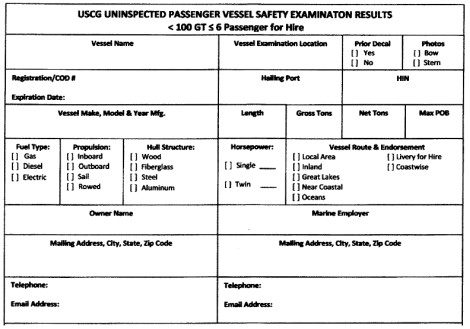
Personnel Licensing
Every UPV must be under the direction and control of an individual licensed by the Coast Guard. There is no requirement for mates or other UPV personnel who are not in control of the vessel to hold a Coast Guard license or document, however any mate who controls the boat must be licensed. The watch limit is 12 hours, so if a captain is the sole employee on board, then the time limit for the charter is 12 hours. Any charter that exceeds 12 hours should have a second licensed person to stand watch. Anchored vessels must have a watchstander. One of the worst live aboard dive boat accidents occurred when there was a fire on board while the boat was anchored, and the passengers were sleeping.
Documentation: Vessels > 5 Net Tons
A UPV of at least 5 net tons that engages in domestic or coastwise trade must have a Certificate of Documentation (COD) on board bearing a valid endorsement for the activity in which it is engaged. Net tons is a non-linear measurement of the internal volume of the vessel. Generally, vessels over 26 feet in length qualify for documentation. In Texas a vessel must also be state registered, and the registration sticker must be displayed on the bow on both sides of the vessel. No Texas registration numbers need be displayed, but the original registration certificate must be on board and present. The current and original documentation certificate must be carried on board. No photocopies.
Documentation Number Placement:
- BLOCK-type Arabic numerals not less than three inches in height;
- Preceded by the abbreviation “NO.”;
- Must be marked on some clearly visible interior structural part of the hull;
- Must be permanently affixed so that alteration, removal, or replacement would be obvious.
Example: NO. 123456
Documented Vessel Markings
The UPV name must be marked on some CLEARLY visible exterior part of the port and starboard bow and the stern. The hailing port must be marked on some clearly visible exterior part of the stern, the hailing port must be a place in the United States and must include the State, territory, or possession in which it is located.
- For UPVs with a square bow, the name must be marked on some clearly visible exterior part of the bow in a manner to avoid obliterating. The name and hailing port must be marked on some clearly visible exterior part of the stern;
- These markings, which may be made by the use of any means and materials which result in durable markings, must be made in clearly legible letters of the Latin alphabet or Arabic or Roman numerals not less than four inches in height.
Many recreational vessels are documented, but the marking requirements for recreational vessels do not require the recreational boat name to be marked on the bow.
Documentation: Vessels < 5 Net Tons
Vessels that are less than 5 net tons need only be state registered. The current and original (no photocopies) registration certificate must be on board.
Drug and Alcohol Testing
The Coast Guard regulations states that each company, which includes sole operators who carry passengers, tow boats, or are engaged in any other marine commerce, must have a written policy on drug abuse and controlled substances. This policy must be kept in the company’s files and be readily accessible. The easiest way to meet these regulations is by joining a drug testing consortium. The drug rule also requires the maintenance of all records of the administration and results of the program for five years. A consortium prepares and maintains all necessary records and summaries for each firm. The consortium also submits an annual report to the Coast Guard, as required, which states that the company is in compliance and lists the results of employee drug testing. The drug testing requirements are the least understood by operators of UPVs. Many mariners on UPVs work for multiple employers. They must participate in each different employer’s drug program. Their participation in one employer’s program does not carry over to any other employer’s program.
Serious Marine Incident Drug Testing
The marine employer shall ensure that all persons directly involved in a serious marine incident (SMI) are chemically tested within 32 hours for dangerous drugs and within 2 hours for alcohol. The employer must demonstrate the capability to meet the alcohol testing requirements by carrying test kits on board or identify an approved facility where the testing will be conducted for all the vessel’s hours of operation.
Marine Accident and Casualty Reporting
Both documented and undocumented (state numbered) UPVs must be aware of the reporting requirements for marine accidents and casualties. Undocumented UPVs must submit an accident report to the state that issued their numbers, while documented vessels must notify the Coast Guard. Immediately after addressing safety concerns, the owner, master, operator, or person in charge shall notify the nearest Coast Guard Sector whenever a vessel is involved in a marine casualty.
Communications
UPVs of 20 meters and over must have one or more VHF-FM radios onboard and must be capable of transmitting and receiving on channel 22A (157.1 Mega-Hertz). When transiting any waters within a vessel traffic service (VTS) area, a second VHF-FM radio must also be onboard.
Charts and Nautical Publications
As appropriate for the intended voyage, all vessels must carry adequate and up-to-date:
- Paper charts of appropriate scale to make safe navigation possible;
- “U.S. Coast Pilot” or similar publication;
- Coast Guard light list;
- Tide tables, and
- Current tables or a river current publication issued by the U.S. ACOE, or a river authority.
- Copy of Navigation Rules (39.4 feet or greater in length), all navigable waters. An electronic copy of the Navigation Rules is not valid.
Navigation Lights and Sound Signals
UPVs must have and display as required the navigational lights as prescribed in the Navigational Rules. UPVs must have an effective sound signal. The larger the upv the greater the distance that the signal must be heard. UPVs over 39.4 feet must also have a bell (size is determined by the length of the UPV). The bell doesn’t have to be mounted but must be accessible.
Garbage Pollution Prevention
No person may discharge garbage into U.S. navigable waters and tributaries. Applies to UPVs over 26 feet in length. UPVs shall display at least one garbage placard. Garbage placards must be displayed in prominent locations so that crew and passengers can read them.
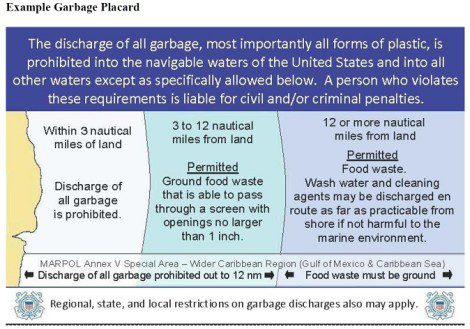
Waste Management Plan
Oceangoing (>3nm) UPVs 40 feet or more in length that are engaged in commerce or equipped with a galley and berthing. UPVs must have a waste management plan detailing who is responsible for the garbage, how it shall be collected, how it is to be stowed, and how it is disposed of.
Lifesaving Equipment
All UPVs must have at least one CG approved TYPE I PFD of a suitable size for each person aboard. Each required life preserver and buoyant device or vest must have a working CG approved PFD light attached to the front shoulder area.
Ring Life Buoy
UPVs 26 feet or longer in length must have at least one CG approved orange or white throwable ring life buoy with a minimum outside diameter of 20 inches. Note: If on an international voyage, the ring life buoy must be orange.
Emergency Position Indicating Radio Beacon (EPIRB)
UPVs less than 100 gross tons are not required to carry EPIRBs. Although not required by regulation, UPVs are highly encouraged to outfit their vessels with a float-free, automatically activated, Category 1, 406 MHz EPIRB. All EPIRBS must be registered with NOAA; see www.beaconregistration.noaa.gov.
Distress Signals
All UPVs must minimally carry three day and three night visual distress signals (VDS) while operating on Coastal Waters (which includes the Great Lakes) and Oceans. All VDS must be current (unexpired date). Any of the following signals, when carried in the number required, can be used to meet these requirements.:
- An electric distress light meeting the standards of 46 CFR 161.013. One is required to meet the night only requirement.
- An orange flag meeting the standards of 46 CFR 160.072. One is required to meet the day only requirement.
- Pyrotechnics meeting the standards noted in Table 175.130.
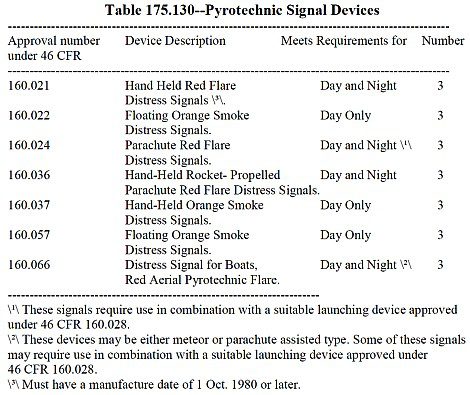
Fire Fighting Equipment
All hand fire extinguishers, semi portable, and fixed fire extinguishing systems shall be USCG approved, or Underwriters Laboratory (UL) listed for marine use and marked as such. All required hand portable fire extinguishers and semiportable fire extinguishing systems must be “B” type; i.e., suitable for extinguishing fires involving flammable liquids, grease, etc. All UPVs of 65 feet in length and smaller shall carry at least the minimum fire extinguishers as set forth in the table below:
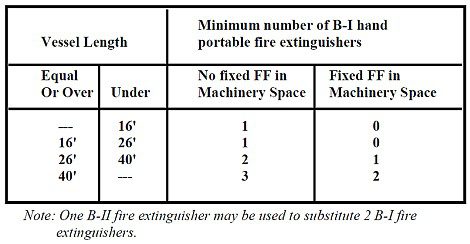
Fire Prevention and Suppression
Gas inboard and inboard/outboard engines must have ventilation ducts, blowers and backfire flame control. Cooking, heating, and lighting systems must be secured, compliant, and have remote shutoff valves.
Safety Instructions and Orientation
Prior to getting underway, operators of UPVs must ensure public announcements, placards, or both are provided to passengers that address the following topics:
- Stowage of life preservers
- Proper method of donning and adjusting the life preservers
- The type and location of all life saving devices carried on the vessel
- The location of the emergency check-off list
- A passenger list or count is done each day. Specifically, the master, owner, charterer, managing operator, or person in charge of the vessel is responsible for ensuring that this is done.
Operators of UPVs shall ensure that an emergency check-off list is posted in a conspicuous and continuously accessible place aboard the vessel.
Emergency Check-Off List
Operators of UPVs shall ensure that an emergency check-off list is posted in a conspicuous and continuously accessible place aboard the vessel. The emergency check-off list must include the following minimum information:
- Measures to be considered for rough weather or crossing hazardous bars
- Measures to be considered in in the event of man overboard
- Measures to be considered in the event of fire at sea
Marine Sanitation Devices
For UPVs with installed toilets, there must be a certified Marine Sanitation Device (MSD, aka holding tank), correct for the boat length. There must be acceptable methods for securing the overboard discharge device to prevent discharge.
Oil Pollution Prevention
No person may intentionally drain oil or hazardous materials from any source into the bilge. No person may operate a U.S. non-oceangoing UPV in U.S. navigable waters unless it has the capacity to retain on board all oily mixtures and is equipped to discharge the oily mixtures to a reception facility. UPVs 26 feet or more in length must have a placard posted in each machinery space and bilge system control station. The placard must be at least 5 by 8 inches, made of durable material, and shall state:
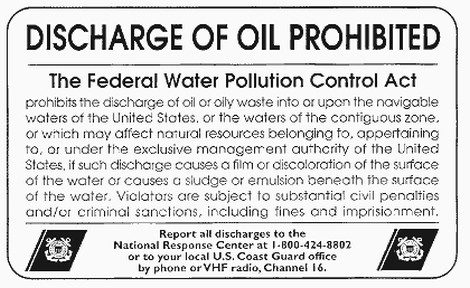
Bilge Oil Retention
Oceangoing UPVs shall have the capacity to retain all oily mixtures on board and be equipped to discharge these to a reception facility, or be equipped with a Coast Guard approved oily-water separator. An oily residue tank is not required on these UPVs. Non-oceangoing UPVs may not be operated in U.S. navigable waters, unless they have the capacity to retain on board all oily mixtures, and are equipped to discharge these oily mixtures to a reception facility. UPVs may retain oily mixtures in the bilges; an oily residue (sludge) tank is not required.
Summary
The requirements for operating an Uninspected Passenger Vessel are outlined above. I have a very detailed guidebook to help captains become compliant with UPV regulations that I will send via email to anyone who requests it at my email address: [email protected]. We also offer Coast Guard UPV vessel exams for free. A one-year certificate is provided to vessels that pass the exam. I can answer any questions you may have about this voluntary inspection program.
[Apr-9-2024]

 Posted in
Posted in 























